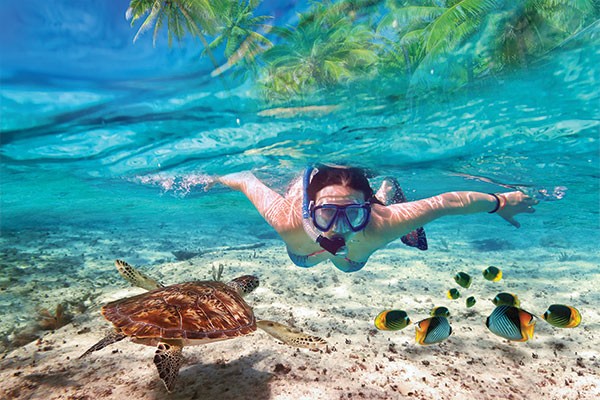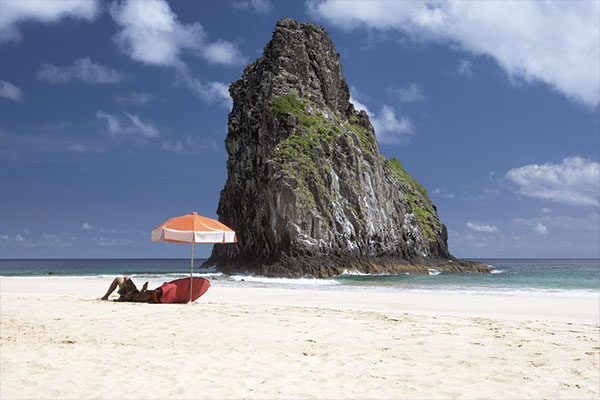Fernando de Noronha
$3250
per personExplore the ecological sanctuary and home of the most beautiful beaches.
Delta now flies direct from ATL to REC.
Fernando de Noronha is the one of the few locations in Brazil where the sun sets into the sea. The archipelago is called Fernando de Noronha. The islands are the remains of volcanic mountains jutting up from the Atlantic. There are 20 small islands, one larger one. This is one of the most spectacular destinations of Brazil, and it’s perfect for honeymooners. This experience is as rewarding as the Big Island of Hawaii or anywhere in the Caribbean.
Rainy season in between April and July. Dry season is August to April, with the best surfing waves from December to February. While Fernando de Noronha is now a model environmental protection area, it is also one of Brazil’s almost hidden treasures. The clarity and warmth of the water, on the equatorial stream, and the abundant underwater life makes these islands a mecca for divers and snorkelers. There are over two hundred species of fish, plus dolphins, sea turtles, and sharks to view and photograph.
Although the islands support a large variety of wildlife species, they are relatively unpopulated and tourism is restricted to 420 visitors at a time. In fact, the longer you stay, the higher your permit fee will go. VIP trip designers can add this destination on to any other Brazil tour we offer.
Summary of the Luxury Fernando de Noronha Tour:
Day 1: Recife & Fernando de Noronha
Today, you’ll arrive in Brazil through the International Airport in Recife, then you’ll take a connected flight, to the island of Fernando de Noronha. A private driver awaits you here to take you to the hotel.
Days 2-3: Fernando de Noronha
For the next two days, take the opportunity to book thrilling excursions in this paradise.
Day 4: Departure from Recife
A private transfer will take you to Fernando de Noronha Airport for a connected flight through Recife to your next destination or flight home.
Comments
-
DepartureRecife/Recife
-
Dress CodeCasual.
-
IncludeEntry Fees5 Star AccommodationPersonal GuideAirport TransfersBreakfast
-
Not IncludedDeparture Taxes
Day 1: Recife & Fernando de Noronha
Days 2-3: Fernando de Noronha
- Snorkel at Atalaia Beach - the sedimentary soil with algae (reefs) creates a big swimming-pool of transparent water. Due to preservation reason, sun block is not allowed when going into the water. This area is protected by IBAMA. Maximum stay allowed: 30 minutes.
- Snorkel with turtles - at Sueste Beach Great place to spot the famous sea turtles.
- Scuba dive: - The best dive site is the archipelago of Fernando de Noronha. It's the most untouched spot, and it's simply gorgeous on the surface, appealing to everyone. The difficulty ranges from beginner to advance. Best time of the year is from July to December for beginners, all year round for advanced divers. It's one of the most expensive dive sites to go.
- Hiking thru other beaches - Sancho Bay is considered to be one of the most beautiful beaches in Brazil. You can access it by boat (swimming) or by trail, from Baia dos Porcos or by dune buggy from up the hill. It´s a secluded, calm beach with crystal clear water, perfect for snorkeling.
- Porcos Bay - snorkeling is great from April to December. Waves from January to March.
- Boldro Beach - This beach has quite a rocky bottom but it is also good for surfing. It has a bar that offers some shade and serves lunch and appetizers.
- Cacimba do Padre Beach - This beach is also known as surfers paradise from January to March. Hang Loose Worldwide Surfing Contest takes place right here. It is the beach right next to Baia dos Porcos and where you can also see "Morro Dois Irmaos" or Two Brothers Peaks.
- Night Activity available - Lectures on fauna and flora at the IBAMA main facility (free of charge) and Forro do Cachorro where locals and tourists dance the typical northeastern dance called ”forro”.
- Capim Acu Trail - 1.6 km of extension (round trip). The presence of a local guide is mandatory. The trail starts at Praia do Leão (first pictures on the left) and ends at Capim-Açu belvedere, which has a steep slope.



























